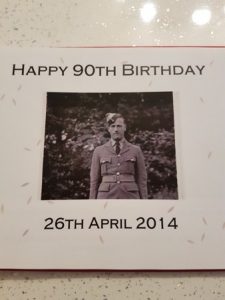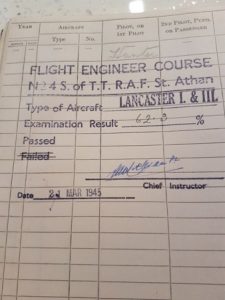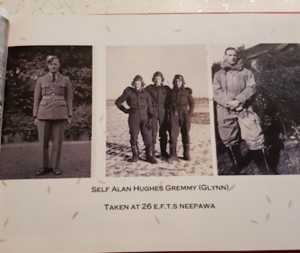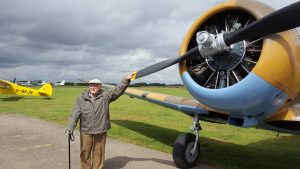Brian Hunter – Flight Sergeant No: 1625589
I was born April 26th 1924 at Stoneferry, Hull, making me 92 years old. As I grew up, All the talk was about Amy Johnson, who flew solo to Australia in a lightweight engine airplane. She was my hero/heroine. I wanted to learn how to fly but knew that it would be impossible as we were a poor family and couldn’t afford it. There was a small grass airfield between Hull and Hedon where a small aero club was based with a few small planes. Once a week a K.L.M (Royal Dutch Airlines) plane would land there, mainly bringing businessmen.

Two of my friends and I would cycle on our bikes to go watch the planes there, we were about 10 years old then.
The K.L.M planes were 3 engines, high wing and carried about 25 passengers.
As I got older I kept enquiring if it was possible for me to join the R.A.F and learn to fly as a pilot but I was just laughed at and told only people who had attended a posh school such as Hymers stood a chance.
Then the war came. I joined the A.T.C (Air Training Corps) and went to classes or lectures two to three times a week. There were three local squadrons, 152, 192 and 1369. I was in 192 sqd. The three co: with the Townend brothers Alec, Jack and Charles. Ours was Alec.
They owned the Townend Wine Co, who had a large warehouse in Wincomblee and a few retail shops. They had a shop at the corner of Cave Street and Beverly Road and a small building further along Beverly Road where a ten-foot went through to Pearson Park.
The ground floor cellar were full of wooden barrels of wine and the first floor was empty offices were we had A.T.C lectures after school.

We were up there having a talk one evening when the air raid sirens sounded. Sometimes the enemy planes were bombing the docks on Hessle and Hedon Road so we carried on unless the bombing sounded to be getting nearer. It seemed to be getting nearer so the lecturer said to me “Right Sgt, take them down to the cellar”, I led them down the stairs and was almost at the door when we heard a bomb coming down and getting louder and louder. We all froze on the stairs and then there was a terrifying thud, the building shook and then quiet. Somebody shouted, “Are we still alive?”. The instructor had found us by now and told us to get going quickly as it might be a delayed-action bomb and could go off any minute. So we jumped on our bikes and went through to a large public air raid shelter in Pearson Park. We stayed there for about half an hour and were quiet. Then even though the all-clear hadn’t sounded, we decided to go home. I was living down Sutton Road with my parents and brother. I got my head down and pedalled as fast as I could. Suddenly all hell broke loose again guns, bombs and searchlights. I suddenly felt a sharp pain in my forehead and fell off my bike. Luckily I was just outside and A.R.P Wardens hut and they helped me up and took me in the hut and bandage my head up. It was bleeding quite a bit. Thank goodness it wasn’t a few inches further on as the piece of jagged shrapnel would have gone right through my head. I was about 15 then.
Eventually at 17 I got my calling up papers to report to Lords Cricket Ground in London. After a few days there doing various tests and checks I was posted along with others to the I.T.W (Initial Training Wing) at Babbacombe next door to Torquay, where we did 3 months training to see what we would be most suitable for. To my delight I was selected for pilot training.

We were then issued with tropical kit and told to be ready to get on a train to Southampton the next morning. This indicated that we would be going to Rhodesia, then parts of South Africa to start our flying training.
We assembled the next morning with all our kit, but after standing around for a long time we were informed that there had been a change of plan and we had to hand all our tropical kit in. We found out later that the ship we were going on had been torpedoed.
The next day we were issued with winter kit and told to prepare for another train journey. This time we went to Scotland and embarked on the Queen Elizabeth 2nd, the longest ship in the world at the time. We set sail during the night. This was her maiden voyage.
3 days later we passed the Azores and continued in a southerly direction. Another three days later, we were entering New York harbour.
We stayed on the QE2 overnight and the next morning disembarked straight onto a train and off we went again. We were never told where we were going but we worked out that we were travelling north toward Canada. It is Thursday Oct 28th 1943.

I nearly forgot, there was a large aircraft factory in Brough a few miles out of Hull. It was Blackburn’s Factory on the banks of the Humber. They used to make mostly seaplanes, flying boots, and a small single-engine biplane trainer called the O2. Later on they made the twin jet called the Buccaneer, which was very successful.
We arrived at Moncton, a small town in Eastern Canada at 2am. We had something to eat and drink and then went to bed. We had to be up early the next morning for a lecture on what we would be doing next. Then we had the afternoon off. We went into the town and looked around and the first thing we noticed was that everything was in French and English and that people spoke both. Of course this part used to be known as French Canada.
Moncton was a sizeable holding unit, where they decided where to send us next. We were all equipped with flying clothing, including 2 flying vests, inner and outer long-sleeved woolly vests, and long john underpants. We were mostly late teenagers or early twenties and just laughed at some of the clothes saying we would never wear such things. Little did we know.
On Nov 24th we left Moncton by train heading for Neepawa, which is about halfway across Canada in the middle of the prairie. The large grass As we thought, the airfield was about a mile outside the village, as we thought later that it is the fifth largest town in Manitoba.
We would be here about 6 months flying Tiger Moth single-engine planes. There are open cockpits in the summer but now have covers over the cockpits made of Perspex by the mechanics. They didn’t fit very well with draughts all around. There are no heaters on the plane but it was very cold.
We all went ice skating quite a lot as all the rivers, lakes etc., were frozen over.

One morning it was very cold when we went up for an hour. After half an hour we all return as it was getting colder. They had to lift us out of the planes as we were too cold to move. We found out later that it was -41. When we finished our course at Neepawa we were passed on to do an advanced course. Some went on twin engines but luckily I went on a Harvard single, we kidded ourselves we would end up on a Spitfire, no such luck. The Harvard was a bigger, heavier and faster, an all-metal, advanced trainer. It was lovely to retract the wheels once you had lifted off. We were flying the Harvard for 6 months before we took our final test and exams.
One evening my Instructor went off to do a night fly cross country. We didn’t have one eveninge radar or any of the modern helps. We had drawn out a plan on the map. There was a thunderstorm a good way away but we were told it wasn’t coming our way so we took off. We were flying at 3,000 feet and after about half an hour we were due to change course when we saw flashes of lightening. We rapidly got closer, and the thunder got louder. The instructor took control and pointed the nose down and full throttle to try and dive out of it. Instead we kept going up and up. The only way we could tell was by the altimeter, we were being tossed about like a cork, despite weighing about a ton and the thunder sounded like bullets hitting the plane. Eventually we were thrown out of the top of the cloud, upside down at 11,000 feet into bright moonlight—what an experience. We abandoned the cross country exercise and headed back to base.

When we finished the course and passed all our exams we were awarded our wings by the Governor-General of Canada, the Earl of Athlone. That was the happiest day of my life, 03.11.44. We then had two weeks leave. Medicine Hat was just near the Rockies so me and three friends decided to take a train through the mountains to Vancouver, which took nearly a day. I loved the mountains and took lots of photos. Returning to camp we handed our flying clothing the following day and boarded the train to take us to the eastern side of Canada and then boarded a boat for England.
We were on that train for three days and three nights when we reached Halifax, Nova Scotia in Eastern Canada and boarded onto a ship, the Mauritania and set off for England. But unfortunately, there were still U-boats out in the Atlantic, so we had to steer an erratic course.
Back in England we did quite a bit of flying on our own in an Oxford and eventually ended up on a Lancaster carrier at North Luffenham. The war in Europe was going our way now, and our forces were pushing the Germans back, and there were not so many enemy air raids.

One day we were doing an exercise off the NW coast of Scotland with another Lancaster. We kept at least a mile apart so we could still see each other. Approaching North Luffenham we were on the final approach with wheels down with the other aircraft going in first and us following. Suddenly the runway lights went out and “Bandits in the area, scatter”. Bandits was the code word for enemy night fighter. We put our lights out and changed course just in time to see the other aircraft being shot down into a quarry, all but the rear gunner were killed and he was badly injured. We were circling four miles away and never saw the enemy aircraft again. Eventually we were given the all-clear to return to base.
After finishing the Lancaster conversion course we were sent on leave expecting to be sent to the Far East to fight the Japanese as the war in Europe was almost over and the defeat of Hitler imminent. Our leave was extended to 6-7 weeks, which we could not understand.
Apparently “them up top” knew something we didn’t. The Americans dropped 2 atomic bombs on 2 cities in Japan, wiping out everything in Nagasaki and Hiroshima. The Japanese surrendered and the war was over.
Our leave was extended again and eventually we were recalled and put on a course flying UT (under training) navigators around, a bit of a come down after the Lancaster.

We were eventually demobbed and I went back to my previous job, at a wholesale tobacconist and confectioners. I thought I might get a job flying but there were so many people being released with a lot more flying hours and experience than me that I didn’t stand a chance.
I joined a flying club just through Bridlington, but then I got married and the family came along and I just couldn’t afford to keep it up.
Then recently my daughter Kathryn took me to a light aircraft display at Leven grass airfield. We enjoyed it. While there I met Dave and Ian, members of the club who were friendly and helpful and took some photos of me and the Harvard. They later gave me some lovely large and framed photos.
They recently took me up for a flight in the Cessna single-engine high wing plane. We were up for about an hour and went to Hornsea, along to Spurn Point and back up the Humber to the bridge then back to the airfield. It was lovely; I enjoyed it and took lots of photos.
